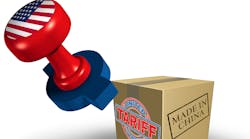In 2019, something impressive happened in U.S. manufacturing. For the first time in six years, the share of U.S. manufacturing demand met by American-made goods increased. And according to the Reshoring Index we’ve produced at the Coalition for a Prosperous America (CPA), it's the first time in this century that U.S. manufacturers have been able to win back share from importers in the later stage of an economic recovery. That’s important, because America’s domestic market is crucial for manufacturers—and was worth $7 trillion last year.
Recent tariffs are a large part of this success. That’s why, regardless of who occupies the Oval Office next year, the United States should continue to use tariffs as part of a whole-of-government strategy to keep reshoring important industries.
Beginning in January 2018, the Trump administration levied tariffs on a series of industrial sectors. Those were followed by tariffs on over half of U.S. imports from China, and ranged from 10 to 25%. That margin gave domestic producers a cushion of protection against heavily subsidized foreign imports. And as our CPA Reshoring Index shows, the largest gains occurred in durable goods, even as net offshoring continued in tariff-free, non-durable goods.
In addition to a quantifiable increase in domestic manufacturing, the tariffs also gave America’s manufacturers a psychological boost—that the federal government would be more dedicated to supporting domestic producers. This matters because businesses want to make long-term deals with suppliers. The prospect of continued tariffs provides a strong incentive to continue seeking out domestic supply chains.
Perhaps the best indicator of the tariffs’ impact is in the important ‘Computers and Electronics’ sub-sector—where China is the largest source of imports. Import penetration in that sector fell by more than 4 percentage points in 2019, to 67.6%. In fact, by Q2 of 2020 it was down further, to 61.2%—its lowest level in a decade.
The tariffs have unleashed a wave of investment in targeted sectors. Steelmakers including Nucor, Steel Dynamics, and Big River Steel are building new mills in Florida, Arkansas, Texas, and other states. And these new facilities are in “flyover country” that badly needs investment. Thanks to tariffs on washing machines and solar panels, there has been a wave of additional investment—including from foreign-owned companies that are seeing the U.S. as a market where they want to manufacture and sell. In fact, U.S. producers now account for roughly 30% of market share for solar panel sales.
The improvement in U.S. manufacturing pre-pandemic brought with it a surge of good jobs. In the three years from December 2016 to December 2019, the U.S. added 510,000 manufacturing jobs, according to data from the Bureau of Labor Statistics (BLS). It’s the first time in this century that the U.S. has added more than half a million manufacturing jobs in a three-year period.
This growth in manufacturing and the overall U.S. economy through December 2019 is also reflected in family income data. The Census Bureau recently reported that U.S. real median family income reached $68,703 in 2019, up an impressive 6.8 percent over 2018. Along with this growth in family income came lower unemployment rates. Last December, unemployment hit 3.5%, its lowest level since 1969.
The vast majority of the economics profession continue to argue that free trade is a better path for the United States. But their views are based on unrealistic, theoretical models. For example, they claim that tariffs raise consumer prices.
However, the tariffs imposed since 2018 have not noticeably impacted prices. September BLS data show the annual rate of core consumer inflation at 1.7%. In fact, inflation has hovered around 2% for most of the past decade. The tariffs have not made a noticeable dent.
In the real world, what the U.S. has seen is a brief surge in prices in the first few months after a tariff is announced—when hoarding and rush purchasing drive up prices. But that quickly subsides, and prices fall back to normal levels. A good example are steel prices, which today are lower than they were five years ago. The same holds for solar panels and washing machines. Prices simply haven’t been determined by tariffs. And helpfully, the United States, with its massive $20 trillion economy, maintains plenty of domestic competition in almost every industry—enough to guarantee competitive prices.
America’s consumers aren’t paying for the tariffs. As an example, one of the biggest markets for steel and aluminum is the auto industry. According to the latest consumer price data, new vehicle prices are up only 1% from a year ago, less than the increase in inflation or the average weekly wage. And apparel from China is subject to 25% tariffs, yet U.S. apparel prices today are 6% lower than they were a year ago, according to BLS data.
A nation’s long-term economic health is driven by high-growth industries. Tariffs have enabled the U.S. to start turning around the import penetration suffered for the past 20 years. But more must be done. We need to remove the handicap of a U.S. dollar that is roughly 25 %overvalued. And with the country continuing to suffer from the COVID-19 recession, it’s imperative to ensure that growth industries have an incentive to invest domestically—and in a market free of predatory foreign practices.
Jeff Ferry is chief economist at the Coalition for a Prosperous America. Follow him on Twitter at @menloferry.




